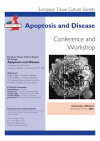Apoptosis and disease: a life or death decision
- PMID: 15218528
- PMCID: PMC1299101
- DOI: 10.1038/sj.embor.7400191
Apoptosis and disease: a life or death decision
Abstract
Conference and Workshop on Apoptosis and Disease
Figures




Similar articles
-
The TRAIL to selective tumor death.Nat Med. 1999 Feb;5(2):146-7. doi: 10.1038/5505. Nat Med. 1999. PMID: 9930856 No abstract available.
-
Death in 2000 ways.Cell Death Differ. 2000 Nov;7(11):1140-4. doi: 10.1038/sj.cdd.4400749. Cell Death Differ. 2000. PMID: 11139288 Free PMC article. No abstract available.
-
The TRAIL DISCussion: It is FADD and caspase-8!Cell Death Differ. 2000 Sep;7(9):759-60. doi: 10.1038/sj.cdd.4400735. Cell Death Differ. 2000. PMID: 11042670 No abstract available.
-
Death and survival: viral regulation of TNF signaling pathways.Curr Opin Immunol. 2003 Feb;15(1):59-65. doi: 10.1016/s0952-7915(02)00018-3. Curr Opin Immunol. 2003. PMID: 12495734 Review. No abstract available.
-
APO2 ligand/tumor necrosis factor-related apoptosis-inducing ligand in prostate cancer therapy.Front Biosci. 2006 May 1;11:1549-68. doi: 10.2741/1903. Front Biosci. 2006. PMID: 16368536 Review.
Cited by
-
Effect of Andrographis paniculata polysaccharide on human retinoblastoma Y79 cell proliferation and apoptosis.Int J Ophthalmol. 2021 Apr 18;14(4):497-503. doi: 10.18240/ijo.2021.04.03. eCollection 2021. Int J Ophthalmol. 2021. PMID: 33875938 Free PMC article.
-
Multiple molecular and cellular mechanisms of action of lycopene in cancer inhibition.Evid Based Complement Alternat Med. 2013;2013:705121. doi: 10.1155/2013/705121. Epub 2013 Jul 21. Evid Based Complement Alternat Med. 2013. PMID: 23970935 Free PMC article.
-
NMR chemical shift study of the interaction of selected peptides with liposomal and micellar models of apoptotic cells.J Biol Inorg Chem. 2014 Dec;19(8):1367-76. doi: 10.1007/s00775-014-1195-5. Epub 2014 Oct 7. J Biol Inorg Chem. 2014. PMID: 25287364
-
Scythe/BAT3 regulates apoptotic cell death induced by papillomavirus binding factor in human osteosarcoma.Cancer Sci. 2009 Jan;100(1):47-53. doi: 10.1111/j.1349-7006.2008.00991.x. Epub 2008 Oct 29. Cancer Sci. 2009. PMID: 19018758 Free PMC article.
-
Caspase-like proteins: Acanthamoeba castellanii metacaspase and Dictyostelium discoideum paracaspase, what are their functions?J Biosci. 2014 Dec;39(5):909-16. doi: 10.1007/s12038-014-9486-0. J Biosci. 2014. PMID: 25431419 Review.
References
-
- Adams JM (2003) Ways of dying: multiple pathways to apoptosis. Genes Dev 17: 2481–2495 - PubMed
-
- Arhel NJ et al. (2003) The retinoblastoma protein interacts with Bag-1 in human colonic adenoma and carcinoma derived cell lines. Int J Cancer 106: 364–371 - PubMed
-
- Basu S, Totty NF, Irwin MS, Sudol M, Downward J (2003) Akt phosphorylates the Yes-associated protein, YAP, to induce interaction with 14-3-3 and attenuation of p73-induced apoptosis. Mol Cell 11: 11–23 - PubMed
-
- Bergamaschi D et al. (2003) iASPP oncoprotein is a key inhibitor of p53 conserved from worm to human. Nat Genet 33: 162–167 - PubMed
Publication types
MeSH terms
Substances
LinkOut - more resources
Full Text Sources

